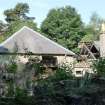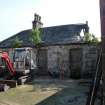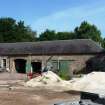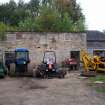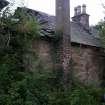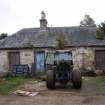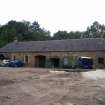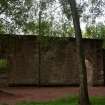Ordnance Survey licence number AC0000807262. All rights reserved. © Copyright and database right 2024.
Useful Links
- Canmore:
- CADDER, CAWDER HOUSE, STABLES
- Historic Scotland:
- HS Reference No 22276
General Details and Location
Category
AT RISK
Name of Building
Cawder House Stables
Other Name(s)
Cadder House Stables
Address
Cawder Golf Club, Bishopbriggs
Locality
Postcode
Planning Authority
Divisional Area
Reference No
3119
Listing Category
B
OS Grid Ref
NS 60668 72591
Location Type
Urban
HS Reference No
22276
Description
Courtyard plan stable complex, comprising original 3-bay, 2-storey stable and hayloft with flanking single storey carriage houses to N range; early 19th century, single storey stores to W range; cottage to SW and carriage houses to SE of S range; cottage to E range. Classical detailing to exterior of N range, facing Cawder House and driveway.
Cawder Stables are an important group of farm and stable buildings lying to the immediate SE of Cawder House. The buildings show a contrast between two building phases which together form the courtyard. The stables first appear in this place on Richardson's map of 1795 in a N-facing, U-plan arrangement, part of which has been retained as the N range. On Forrest's 1816 map, the stables have changed to a courtyard plan, the E, S and W ranges probably having been added during the contemporary improvements to the estate carried out by David Hamilton.
Charles Stirling (owner and benefactor of Cawder House) was an enthusiastic patron of his work, and prior to taking ownership of Cawder, Stirling had commissioned Hamilton to build his previous mansion, Kenmure House (now demolished, on the site of Bishopbriggs Golf Club to the SW of Cawder). Hamilton then executed the Cawder Estate improvements between 1813 and 1815, before returning to Cadder again in 1825 to build Cadder Parish Church.
Of the four ranges, the N range is particularly interesting, as it shows a contrast between the classical detailing applied to the N elevation, the public facade which would be seen by those arriving by carriage up the driveway, and the S facade where the classical detailing disappears from the doorways, being more utilitarian in nature. Additional, later buildings to the S and SE of the courtyard have since been abandoned and largely removed, with only the shell of one cottage surviving to the S.
The mixed usage of the name Cawder and Cadder to describe the house, village and estate can be a source of some confusion. In the ancient maps of Richardson and Forrest, the parish is marked as 'Cadder' (the parish being one of the original 365 designated parishes), whilst the House and estate are marked as 'Calder'. The use of 'Calder' has since disappeared, and until the early 20th century the estate, village and parish were all refered to as Cadder. The use of the name Cawder was adopted by the golf club and this has since become the most common name for the House and its related estate, whilst the village and parish have continued to be called Cadder. These changes in name and spelling have been put down to gradual changes in dialect and pronunciation through time. (Historic Scotland)
Cawder Stables are an important group of farm and stable buildings lying to the immediate SE of Cawder House. The buildings show a contrast between two building phases which together form the courtyard. The stables first appear in this place on Richardson's map of 1795 in a N-facing, U-plan arrangement, part of which has been retained as the N range. On Forrest's 1816 map, the stables have changed to a courtyard plan, the E, S and W ranges probably having been added during the contemporary improvements to the estate carried out by David Hamilton.
Charles Stirling (owner and benefactor of Cawder House) was an enthusiastic patron of his work, and prior to taking ownership of Cawder, Stirling had commissioned Hamilton to build his previous mansion, Kenmure House (now demolished, on the site of Bishopbriggs Golf Club to the SW of Cawder). Hamilton then executed the Cawder Estate improvements between 1813 and 1815, before returning to Cadder again in 1825 to build Cadder Parish Church.
Of the four ranges, the N range is particularly interesting, as it shows a contrast between the classical detailing applied to the N elevation, the public facade which would be seen by those arriving by carriage up the driveway, and the S facade where the classical detailing disappears from the doorways, being more utilitarian in nature. Additional, later buildings to the S and SE of the courtyard have since been abandoned and largely removed, with only the shell of one cottage surviving to the S.
The mixed usage of the name Cawder and Cadder to describe the house, village and estate can be a source of some confusion. In the ancient maps of Richardson and Forrest, the parish is marked as 'Cadder' (the parish being one of the original 365 designated parishes), whilst the House and estate are marked as 'Calder'. The use of 'Calder' has since disappeared, and until the early 20th century the estate, village and parish were all refered to as Cadder. The use of the name Cawder was adopted by the golf club and this has since become the most common name for the House and its related estate, whilst the village and parish have continued to be called Cadder. These changes in name and spelling have been put down to gradual changes in dialect and pronunciation through time. (Historic Scotland)
Building Dates
Early to mid 18th century; remodelled early 19th century
Architects
remodelled by David Hamilton
Category of Risk and Development History
Condition
Very Poor
Category of Risk
High
Exemptions to State of Risk
Parts of the complex are in use by the golf club and are not considered at risk.
Field Visits
24/08/2007, 30/06/2010, 9/5/2013
Development History
August 2007: External inspection reveals the north and east ranges to be derelict. The south and west are used to house equipment used by the golf club. The north building is a shell. The roof of the east building has collapsed at its southern end.
June 2010: External inspection finds the site remains in partial use by the golf club. The in use buildings are not considered to be at risk. The other buildings continue to deteriorate. Damaged roofs are in poorer condition than our previous visit. Plants are growing on wallheads and in masonry joints.
October 2011: East Dunbartonshire Council report (dated March 2011) on the current Buildings at Risk notes the presence of the stables on the Register and recommends the Council contacts the owners to ascertain intentions for the buildings and encourage maintenance/ restoration.
9 May 2013: Limited access to the site, but from what can be viewed there is no significant change from the previous site visit.
14 February 2024: Desk-based assessment suggests the building remains At-Risk.
Guides to Development
Conservation Area
Cadder
Planning Authority Contact
PAC Telephone Number
0141 578 8600
Availability
Current Availability
Unknown
Appointed Agents
Price
Unknown
Occupancy
Part
Occupancy Type
Tenant(s)
Present/Former Uses
BARR original text : Stables to Warehouse/Store
Name of Owners
Unverified see FAQ on ascertaining ownership
Type of Ownership
Unknown
Information Services
Additional Contacts/Information Source
Bibliography
Online Resources
Classification
Ancillary Buildings
Original Entry Date
13-JAN-06
Date of Last Edit
23/07/2018



